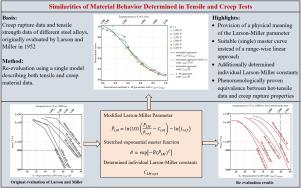Re-evaluation of tensile and creep rupture data of metals using a modified Larson–Miller approach
IF 5.3
2区 工程技术
Q1 MECHANICS
引用次数: 0
Abstract
More than 70 years ago, in 1952 Larson and Miller adapted an existing relationship which evaluates the relative effects of time and temperature on creep rupture behavior of various alloys by using existing data and by constructing so-called master curves. Since that time, the formulated Larson–Miller relation, commonly known as Larson–Miller parameter, is a widely used time–temperature parameter for various applications, e.g. for rupture life, creep and relaxation analyses of metals and some other materials such as polymers, concrete and ceramics. Nevertheless, the physical meaning of this parameter as well as the determination of master curves are still the subject of major criticism.
In this work, both aspects are reviewed and analyzed with data originally considered in the paper of Larson and Miller based on the following approach: (a) the parameter was modified regarding a reference time and a reference temperature according to the time–temperature superposition principle; (b) master curves were generated for five materials investigated originally by Larson and Miller, based on a stretched exponential function type.
It has been shown, that: (1) With normalized time and temperature, the Larson–Miller parameter corresponds to real logarithmic rupture time. (2) For the relationship between creep rupture stress and the modified Larson–Miller parameter, the stretched exponential function is a good choice as a master function. (3) Corresponding model parameters have physical meaning and can be easily determined based on data from creep test data. The investigations provide a better understanding and applicability of Larson–Miller approach.

用改进的Larson-Miller方法重新评估金属的拉伸和蠕变断裂数据
70多年前,1952年,拉尔森和米勒利用现有的数据和构造所谓的主曲线,对现有的关系进行了调整,该关系评估了时间和温度对各种合金蠕变断裂行为的相对影响。从那时起,公式拉尔森-米勒关系,通常被称为拉尔森-米勒参数,是广泛应用于各种应用的时间-温度参数,例如金属和一些其他材料(如聚合物、混凝土和陶瓷)的断裂寿命、蠕变和弛豫分析。然而,该参数的物理意义以及主曲线的确定仍然是主要批评的主题。本文利用Larson和Miller论文中考虑的原始数据,对这两个方面进行了回顾和分析,方法如下:(a)根据时间-温度叠加原理,对参考时间和参考温度进行了参数修正;(b)最初由Larson和Miller研究的五种材料基于拉伸指数函数类型生成主曲线。结果表明:(1)当时间和温度归一化时,Larson-Miller参数对应于真实的对数破裂时间。(2)对于蠕变破裂应力与修正Larson-Miller参数之间的关系,可以选择拉伸指数函数作为主函数。(3)相应的模型参数具有物理意义,可以很容易地根据蠕变试验数据确定。这些研究提供了对Larson-Miller方法更好的理解和适用性。
本文章由计算机程序翻译,如有差异,请以英文原文为准。
求助全文
约1分钟内获得全文
求助全文
来源期刊
CiteScore
8.70
自引率
13.00%
发文量
606
审稿时长
74 days
期刊介绍:
EFM covers a broad range of topics in fracture mechanics to be of interest and use to both researchers and practitioners. Contributions are welcome which address the fracture behavior of conventional engineering material systems as well as newly emerging material systems. Contributions on developments in the areas of mechanics and materials science strongly related to fracture mechanics are also welcome. Papers on fatigue are welcome if they treat the fatigue process using the methods of fracture mechanics.

 求助内容:
求助内容: 应助结果提醒方式:
应助结果提醒方式:


